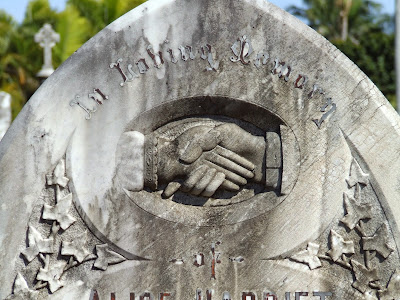Key symbols commonly found
on Catholic graves
Roman Catholic monuments in
 |
| An example of a 'Celtic' style cross, which includes the IHS symbol. Photo: T. Fielding. |
During the years the
Key symbols commonly found on
non-Catholic graves
One of the key differences between Roman
Catholic monuments and non-Catholic monuments is that non-Catholic adherents
(though there were exceptions) did not utilise the cross in commemorating their
dead. The cross ‘was shunned as being
too popish and iconographic for funerary monuments’. The Protestant view was that the use of the
Virgin Mary, the Saints, and even the crucifix would encourage the worship of
idols, rather than God. In the Georgian
period the non-Catholic religions erected plain-shaped headstones (Gothic,
Norman and anthropomorphic) and used a minimum of decoration but in the
Victorian and Edwardian eras more and more decoration was employed, and
memorials took the shape of obelisks, columns, urns, pedestals, pediments,
ledger stones and table-tops. Angels and
weeping willows could be found on Church of England headstones, but figurative
sculpture was less popular among non-conformist religions such as the
Presbyterians, Weslyans and Independents.
 |
| An example of an 'anthropomorphic' shaped headstone. Photo: T. Fielding |
The symbolism on non-catholic headstones in the West End Cemetery
By the 1930s, monuments such as obelisks and
pedestals with draped urns and broken columns became popular large monuments in
the West End Cemetery West
End Cemetery
In this article I’ve only focused on the five
most common religions represented in the cemetery. Up to the year 1900, those
five religions (Church of England, Roman Catholic, Presbyterian, Weslyan and
Methodist*) accounted for approximately 85% of burials. The other three largest
groups recorded were listed as Pagan, Heathen and unknown. While they were recorded as such, it’s likely
that many of these last three groups were actually Indigenous, or of Chinese or
South Sea Island
* Both
Weslyan and Methodist were recorded as separate religions in the West End Cemetery


